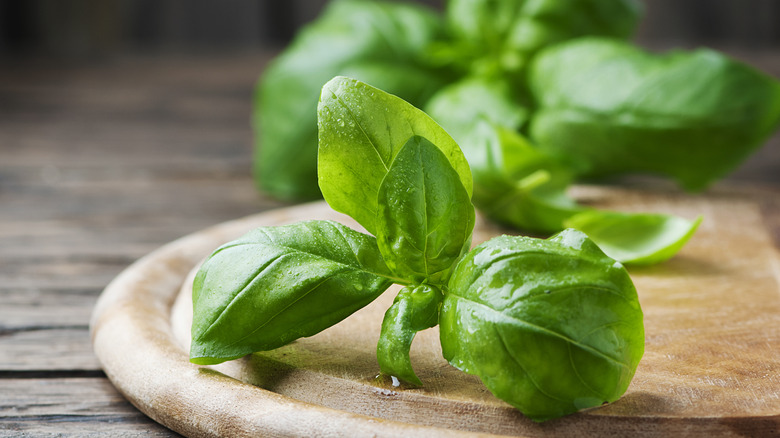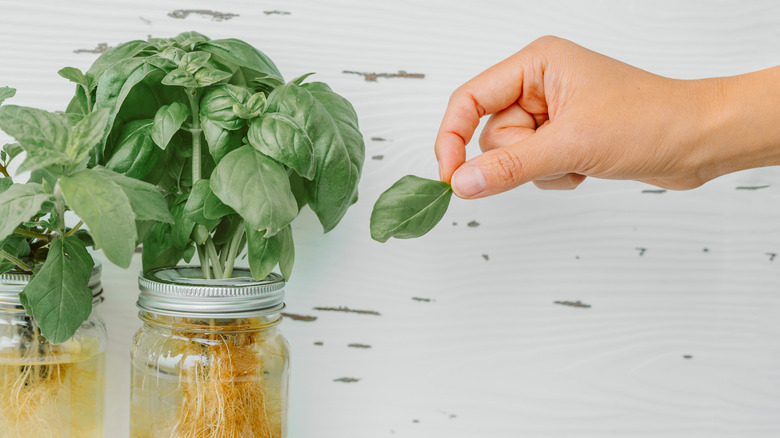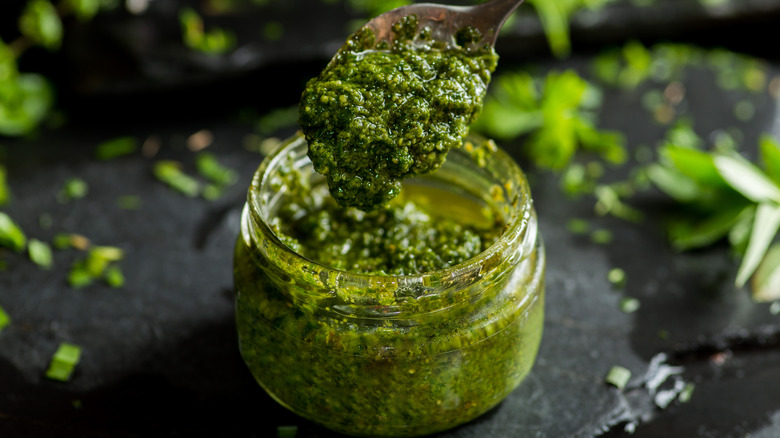Think Twice Before Storing Basil In The Fridge
There are few things worse than coming home with an armful of fresh herbs, only to have them go bad before you can use them up. Most of the time, it's relatively easy to avoid the mistakes everyone makes when storing herbs – so long as you know what to do. When it comes to basil, however, your playbook needs to look a little different.
Where most herbs should be stored in the refrigerator — often with their stems submerged in water — basil needs to be stored at room temperature for the best results. This is because it is a warm weather crop; it's grown in hot climates, so the cold of the refrigerator can damage its leaves and flavorful oils.
If your basil has stems, submerge them in a glass filled with an inch of water, and keep it out like a bouquet of flowers. Not only will this look beautiful, but it will make your kitchen smell great too. For best results, snip the very bottom of the stems to give them better access to the water. If you have a collection of basil leaves without stems, put them in a loose plastic bag on the counter. Just make sure the bag is slightly open. If it is sealed, the basil will release moisture and wilt.
Humidity, temperature, and washing
When storing your basil at room temperature, you should always place it somewhere out of direct sunlight that is cool and dry. The plant thrives at temperatures of 50 to 68 degrees Fahrenheit, so direct sunlight can cause it to grow too hot. Similarly, it holds best at a 90 to 95% relative humidity. You can control the humidity by loosely wrapping the fresh basil in a bag. Once again, storing it in a hotter area makes it more difficult to control this process.
You should also avoid handling the basil as much as possible. Because it is a very tender herb, basil will bruise easily when overworked. You should wait to wash basil until right before you use it. Furthermore, if you wash the herb too vigorously, its flavorful oils will be rinsed off and its leaves can be easily damaged. To rinse it properly, wait until just before you're going to use the plant, and then rinse your basil under cold running water as gently as possible. Once you have removed all of the dirt and grit, dry the leaves immediately afterward – a salad spinner works great here, but you can also use clean, dry towels.
How to save wilting basil
No matter how carefully you store your basil, it's going to wilt eventually. Its lifespan can last anywhere from five days to up to two weeks. Once your basil starts to lose its vibrant green hue, however, there's no need to throw it out.
First of all, basil in the early stages of wilting makes an ideal candidate for pesto. Because the basil is getting pulverized, a few bruises and textural deficiencies won't be an issue. It is also especially good to use for a pesto recipe with blanched basil. By simmering the herb for five to 15 seconds and then shocking it in an ice bath, you bring out its chlorophyll pigments, which causes the herb to turn bright green. This compensates for any discoloration that has occurred to the leaves.
The freezer is also your friend in this situation. You can freeze your blanched and dried basil leaves in an airtight container. You can also freeze the herb into flavorful nuggets. To do this, simply chop your basil and mix it with oil or butter, and then freeze the mixture in an ice cube tray. Pull these herb cubes out to add to sauces, soups, or stir-fries for a bright punch of flavor. Just keep in mind that they will be best used in cooked applications, not as a garnish.



